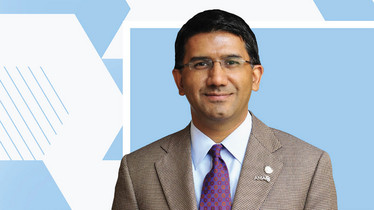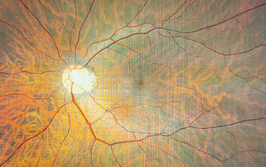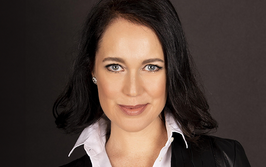Leading, Advocating, Challenging
Sitting Down With… Ravi Goel, Ophthalmic Surgeon, Wills Eye Hospital, USA

How – and why – did you get into ophthalmology?
When I was in medical school, at the start of Clinton’s presidency, there was an increasing effort to push aspiring medical students into primary care. Medical specialties were de-emphasized, and it was difficult to find mentors – so I had to seek out my own. But I was fortunate that my brother was also in medicine, four years my senior, and he had matched into ophthalmology. So when I was in a second year medical student, he was a first-year ophthalmology resident. That sibling connection gave me a great insight into ophthalmology. I quickly realized that ophthalmology is an outpatient specialty and primary care of the eye. Ophthalmologists have a role in helping all kinds of patients, including those with systemic disease, such as diabetes and high blood pressure. I soon knew what I wanted to do. I’m not sure what I would have done if I hadn’t chosen ophthalmology – maybe urology? You often hear that the nicest people in medicine end up in either urology or ophthalmology!
Where did you train?
I started out at the Greater Baltimore Medical Center in Baltimore, Maryland, which was chaired by CP Wilkinson – a leader in academia, retina societies, and a past president of the American Academy of Ophthalmology. During my second year, our program merged with the Johns Hopkins Wilmer Eye Institute. My mornings (including many weekends!) would start with lectures at Wilmer and then clinical rotations at Greater Baltimore Medical Centre. I’m reluctant to list all my mentors during this period – there were so many, a dozen or more, and I wouldn’t want to inadvertently leave someone out. People helped me in all kinds of ways. There are a number of ophthalmic surgeons whom I’ve never met that I’d consider as mentors, because I learned lifelong surgical techniques and pearls from their videos. That was back in the days when surgery training videos were recorded on VHS tape and mailed to residents!
What changes have you seen during your career?
Overall, incisions have become smaller, instrumentation more efficient and technology with generational advancement. When I was training, anterior segment surgeons were just beginning to shift from extra-capsular surgery to phacoemulsification. Surgical device companies have gone through two or three generations of technology advances since the earliest phacoemulsification machines. Our approach to macular degeneration has revolutionized thanks to advances in anti-VEGF drugs. When I was starting out, we’d see our AMD patients every three to six months and could only offer argon laser treatment. We’d tell patients a sad truth: laser therapy would make their vision worse, but not as bad as it would be in five years if we did nothing. Similarly, glaucoma management has been fundamentally changed by the advent of MIGS and procedures that have been pioneered by colleagues globally.
Another positive change is our advanced ability to correct astigmatism and empower patients. We want the optics of the eye to function as efficiently as possible. Again, this beneficial change has been technology-driven – with advances in IOL technology, such as toric, multi-focus, extended focus lenses, and now trifocal lenses. But all these developments relate to our mission as ophthalmologists: to protect sight and empower lives. And that mission is so important; we must remember that in many countries, loss of sight in an adult may mean that a child has to leave school or work to act as a care-giver. The multigenerational consequences of blindness are profound – and the impact of preventing vision loss therefore is equally far-reaching.
Looking back, what makes you most proud?
I was drawn to the Academy’s educational and research mission as a member of the Young Ophthalmologist Committee (2002-2006). During my early years in private practice, our nation’s veterans faced a threat to high-quality ophthalmic care at the nation’s Veterans Health Administration. As part of the Leadership Development Program (LDP VI), I presented “Complications of Laser Surgery” with a live laser demonstration at an AAO and VETs Act Coalition symposium at the US Capitol (2004). (We actually shipped a laser to DC so that I could demonstrate the technology!) I learned the importance of patient advocacy and relationships with legislators in our mission of protecting sight. LDP is among the Academy’s crown jewels. I developed essential skills and formed relationships with AAO leaders who advocate for patients across the country.
During a nearly two-decade journey, I’ve continued to serve the Academy in numerous capacities, including the AAO Revitalization Study Group (2007-2008). As an AAO delegate to the American Medical Association, I’ve advocated on the front lines as critical issues are presented, which have the potential to either protect or threaten sight. As Vice Chair of the AMA Ophthalmology Section Council and former chair of the AMA Young Physicians Section (2010-2011), I also work with leaders across medical specialties on critical issues which affect patients and the practice of medicine nationwide.
Recently, I served on the American Academy of Ophthalmic Executives (AAOE) Board of Directors (2014-2017). I helped develop and currently serve as Program Director of the Ophthalmology Business Summit (2018-present). Through collaboration between physician and administrator leaders, the AAOE continues to identify objectives, amplify strength, and achieve key results.
I have dedicated my professional life to being a clinician, surgeon, and patient advocate. As a member of the Communications Secretariat (2013 - present) and clinical spokesperson for the Academy, I’ve experienced firsthand the importance of media training and messaging across numerous platforms. Through social media, I’ve worked to educate the public on critical issues within ophthalmology and across the house of medicine. Every four to five years there is a national-level issue that affects ophthalmology and our patients. I especially value relationships and the coalition of ophthalmologists and physician colleagues as we work together to help patients.
Despite all that, I think the moments when I’ve helped patients lead happier, more independent lives must be my proudest accomplishments. It’s hard to beat enabling somebody to return to driving and numerous activities of daily living when previously they were limited by a mature cataract.
How are your working days (and nights!) filled?
My main focus is always patient care; aside from that, I am heavily involved in ophthalmology leadership activities. I served as program director of the AAO’s Ophthalmology Business Summit. This conference takes place over one weekend each year. 2019 was only the second year, and we sold out the meeting! I also work with a team of ophthalmology colleagues and practice administrators at the American Academy of Ophthalmic Executives – I was member of the board of directors there a few years ago, and beginning in 2020 will serve as Senior Secretary for Ophthalmic Practice. This portfolio of activity partly reflects the ongoing transformation of ophthalmic practice – private equity is increasingly involved in the sector, often supporting mergers between practices, and physicians across medicine are increasingly employed by healthcare systems.
Near-term challenges for ophthalmology include those related to regulatory issues, MIPS and Medicare, and these take up a lot of my time. I cover many of them in my blog, protectingsight.com, but I also blog on other topics; for example, I recently highlighted favorite videos from colleagues who performed surgery on white cataracts. This type of content can be useful for many people: a friend of mine is resident of a top 5 ophthalmology residency program and found this resource helpful for his own surgery. Overall, it’s clear that effective use of social media can be a powerful educational tool for colleagues around the world, and helps break down barrier. But truthfully, just being an ophthalmologist challenges borders! I’ve been to India twice to perform cataract surgery at Aravind Eye Hospital, and another time I traveled to Amar Agarwal’s Hospital to do train in advanced LASIK surgery techniques. And I use Instagram to follow colleagues worldwide, and learn pearls from them all the time. So international borders are increasingly being broken down as professional education advances.
What advice would you give today’s up-and-coming ophthalmologists?
First of all: finish your training. Do a fellowship, if that’s what interests you. But know this: in a few years’ time, some issue will arise that will affect you as a physician, as a surgeon, and as a member of your community. And when something happens that affects your patients and your ability to perform medicine and surgery, maybe you should look for – and take – opportunities to address that issue, rather than hiding away in your office or your clinic. So, when the need arises, spend time going to your state house, engage in social media, and do what it takes to build a coalition to advocate for your patients and the profession. In brief, my advice to those starting out in ophthalmology is – get active!
What is your opinion on diversity and equality in ophthalmology?
Diversity is paramount to an advancing profession. And it’s very important for organizers, speakers, thought leaders – all of us – to be aware of implicit bias. I remember the movement on social media called “I Look Like an Engineer?” That was about female engineers posting photos of themselves, their interests, passions and hobbies. This was followed by two female residents in general surgery who launched “I Look Like A Surgeon.” The #ILookLikeASurgeon has generated more than 1 billion impressions on social media. It became a powerful hashtag for thousands of colleagues.
But there’s still so much more to do; for example, I recently criticized a surgical device company on social media because their advisory panel comprised six men – what is often called a “manel!” Zero of their 60 educational videos on eyetube channel included female experts. Since my call-out, a dozen of 88 videos now include female colleagues.
There are positive exceptions. For example, Wills Eye Hospital runs excellent Saturday morning educational sessions throughout the year. A recent glaucoma course included five specialists, comprising four women and one man. Ophthalmic World Leaders (OWL) and Women in Ophthalmology (WIO) do great work in broadening diversity in the profession. These developments are timely – after all, women now represent more than 50 percent of trainees. But we must all be cognizant of implicit bias and do what we can to promote diversity and equality, including challenging and changing where necessary. I know men who are flying around the world all the time to speak at ophthalmology conferences, and I wish they would step up and refuse to sit on a panel unless it is truly diverse. My own view is that thoughts should prevail, and that thought leaders who wish to take the profession forward should not be stopped by a glass ceiling. We must continue to work together to enable that to happen.
How will eye surgery change in the future?
Well, that depends on the resources invested into the field. If the government made it a priority, for example, by issuing a Surgeon General’s report on vision – just as they did with hearing loss a few years ago – then research funds are likely to follow. But in any case, I think eye surgery will continue to see yet smaller incisions, fewer infections and higher safety. Virtual reality training methods, such as those used at the Wills Eye Institute to train residents on how to deal with complications, will become increasingly commonplace. Similarly, artificial intelligence and machine learning will have ever larger roles, particularly in the management of patients with diabetes or macular degeneration. Robotic eye surgery is further off, but could be the way of the future.
What is your greatest hope for the future of the field?
I’m primarily a cataract surgeon. What interests me is making cataract surgery safer, more efficient and more cost-effective. Ultimately, I’d like to decrease the cost of cataract surgery around the world to the extent that we can make it available to anyone who needs it. That in turn will enable patients and their dependants to lead more fulfilled and productive lives. That’s the dream! But allied to that is a wish to continue to train ophthalmologists around the world to deal with a broad variety of diseases, including glaucoma, macular degeneration and diabetic retinopathy. These patients have severe needs and quality of life issues, especially in the later stages. The ultimate dream, of course, is 20/20 vision for everybody, but that is a very distant goal!

Having edited several technical publications over the last decade, I crossed paths with quite a few of Texere's current team members, and I only ever heard them sing the company's praises. When an opportunity arose to join Texere, I jumped at the chance! With a background in literature, I love the company's ethos of producing genuinely engaging content, and the fact that it is so well received by our readers makes it even more rewarding.













